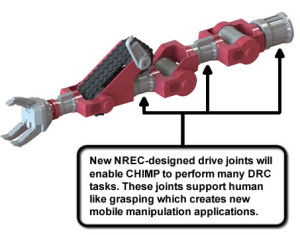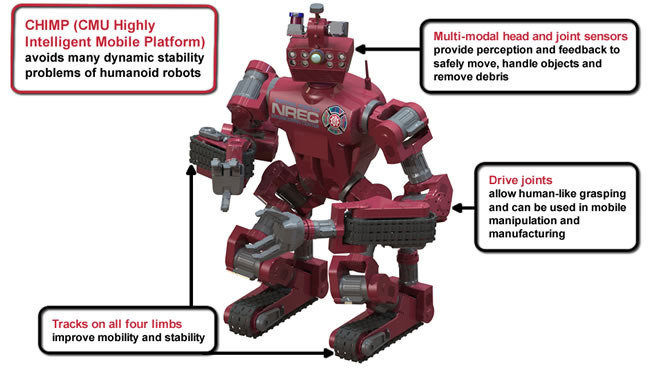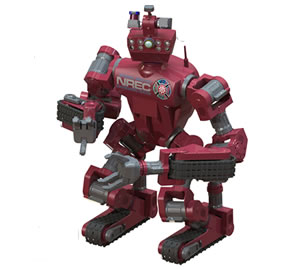
A team from Carnegie Mellon University’s National Robotics Engineering Center (NREC) is building a human-size robot that moves, not by walking, but on rubberized tracks on the extremities of each of its four limbs. With this unique robot the CMU team hopes to win the Defense Advanced Research Projects Agency’s (DARPA) Robotics Challenge.
This ‘CMU Highly Intelligent Mobile Platform’ (CHIMP) will use all four rubber tracks for normal ground movement. The limbs carrying these tracks will also be able to move, enabling the robot to move on two limbs at a time, thus being able to cross rough terrain, obstacles and debris. The limbs will also enable the robot to manipulate objects or operate tools when necessary.
“Humans provide high-level control, while the robot provides low-level reflexes and self-protective behaviors,” said Tony Stentz, NREC director and Tartan Rescue Team leader. “This enables CHIMP to be highly capable without the complexity associated with a fully autonomous robot.” The NREC entry, Tartan Rescue Team, is one of seven selected by DARPA for the Robotic Challenge Track A, in which each team will develop its own hardware and software. The human-centered nature of DARPA Robotics Challenge would seem to favor a dynamically stable humanoid robot, the choice of five of the seven Track A teams, Stentz acknowledged. But his team’s focus on simplicity and dependability led them to choose tracked locomotion.
Like a chimpanzee, each extremity is equipped with a manipulator that enables it to grasp objects;
Near-human strength and dexterity. On-board sensors build a texture-mapped, 3D model of the environment that CHIMP uses to maintain stability and prevent collisions. The same 3D model enables the operator to visualize the location and orientation of CHIMP and evaluate possible actions. Controlling the CHIMP the operator will use an immersive interface of a large screen monitor, keyboard and mouse, where he will be able to choose from multiple modes that blend manual and autonomous control of the robot.

“This type of robot has tremendous potential,” he added. Such a robot would be suitable for a variety of tasks for which NREC now develops wheeled, tracked and other conventional robots, such as remote inspection and monitoring of hazardous industrial facilities. A unit of Carnegie Mellon’s Robotics Institute, NREC performs advanced applied research and prototyping for commercial and governmental clients.
CHIMP will have to do that and more during the competition, in which robots will have human-like capabilities to respond to calamities such as the 2011 Fukushima nuclear plant disaster. Climbing ladders and driving vehicles are among the obstacles robots will face in environments engineered for people.
CHIMP will be able to perform complex, physically challenging tasks through supervised autonomy. A remote, human operator will make high-level commands controlling the robot’s path and actions, while the robot’s on-board intelligence prevents collisions, maintains stability and otherwise keeps the robot from harm. The robot also will be pre-programmed to execute tasks such as grasping a tool, stepping on a ladder rung or turning a steering wheel without step-by-step direction from the human controller, circumventing the lag between command and execution.
“When we walk or stand, our brains are actively controlling our balance all of the time,” Stentz noted. This dynamic balance makes people nimble and enables them to run. But it also greatly increases the complexity, computational requirements and energy consumption of a machine. So CHIMP is designed with static stability; it won’t fall down even if it experiences a computer glitch or power failure. When necessary, however, the operator can control CHIMP’s individual joints, enabling it to adapt its motion to particular circumstances or extricate itself from tight spots.


















